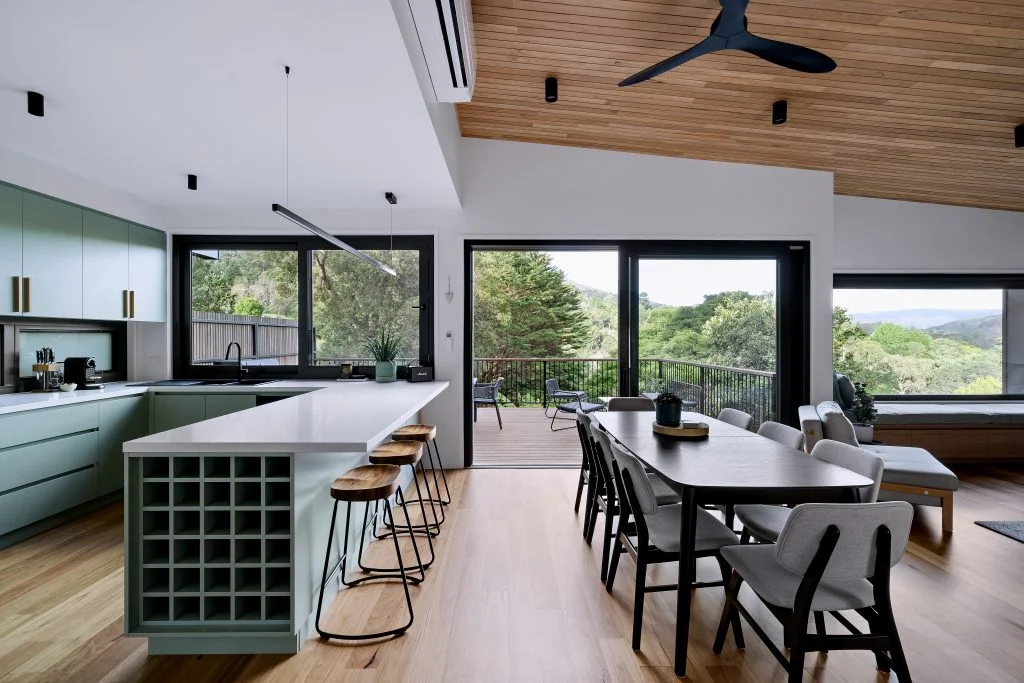-
Australia
Copyright © 2025 Powered by BCI Media Group Pty Ltd
Confirm Submission
Are you sure want to adding all Products to your Library?
Contact Detail

As architecture and construction gears more and more towards sustainability, passive design is going mainstream. It is drawing people’s focus as a great way to improve energy efficiency in a home for the long term, using a ‘materials first’ approach.
Achieving passive design means incorporating elements into the build that lower external energy requirements. One way this can be done is through installing windows with great thermal performance, such as those manufactured by Thermotek.
Engineered in Germany but Australian made in our sustainable facility in Melbourne, the design of Thermotek windows focuses on heat insulation, statics and sealing.
With uPVC window profiles and the options of double or triple glazing, Thermotek windows can regulate temperature and help make a home airtight, thus meeting the tenets of passive design.
They work together with other passive design elements – such as orientation and natural ventilation, to lower the energy consumption and carbon footprint of a home. They can also help reduce noise and are extremely durable.
Let’s take a look at how passive design and energy efficiency go hand in hand.
What are the key elements of passive design?
Passive Houses were developed by Dr Wolfgang Feist in Germany in the 1990s. They have since been adopted across the world as a gold standard of sustainable design, with certification governed internationally by the Passivhaus Institut, and locally by the Australian Passivhaus Association.
True passive design reduces the energy consumption of a building to a minimum while also enhancing the comfort of occupants in both summer and winter.
Certified Passive Houses concentrate on the fabrics in the envelope of the building. This means that they allow the construction materials to do the work and establish both energy efficiency and indoor comfort.
Fundamental Passive Design Principles
A Certified Passive House is built with a dedication to key elements:
To be certified, strict guidelines must be met. When a house meets all the criteria, it should achieve an indoor comfort band of 20-25°C with no more than 10% of the year exceeding 25°C. It also includes limits on humidity.
It’s essential that passive house buildings are designed to be airtight to prevent drafts and leaks, which can be a major source of energy waste.
How does uPVC help with energy efficiency and passive design?
Thermotek window and door systems have a smart, sustainable design that harness Aluplast uPVC profiles.
uPVC is ‘Unplasticised’ polyvinyl chloride. Unlike traditional PVC, chemical plasticisers are not used in the process of making it. Instead, uPVC consists of strong, tough impact modifiers and fillers.
It is strong and versatile as a construction material, with long, spaghetti-like polymers that twist around each other during manufacture to strengthen the material. Impact modifiers are then added to bind the strands together well.
This means that anything made from uPVC – such as the window and door frames manufactured by Thermotek – are very robust.
uPVC also gets stronger with subsequent use. It is up to 6% stronger when it’s recycled the first time. The next four or five times it’s recycled, it will still get stronger but by a gradually decreasing amount. This means that uPVC windows and doors could potentially become stronger and more durable for over 300 years.
All of this makes uPVC an incredibly tough material that’s perfect for passive house windows.
Its surface hardness is equal to aluminium, which makes it an ideal material for windows and doors. It’s also BPA-free and non-toxic (which is why it is now used extensively across the medical industry).
The exceptional insulation qualities of uPVC window and door frames mean they are able to significantly enhance energy efficiency and thermal comfort within your home.
Unlike aluminium frames – which need to be thermally broken to be sustainable – uPVC frames do not conduct heat. This means they effectively prevent high temperatures from entering your home during summer, reducing the reliance on air conditioning. In fact, when combined with double or triple glazing, uPVC frames can potentially eliminate the need for air conditioning altogether!
What other energy efficient elements in Thermotek windows contribute to passive design?
The insulated glass units (IGUs) in Thermotek products incorporate standard Low-E glazing with argon gas, further enhancing energy efficiency.
In addition to superior thermal performance, Thermotek windows and doors ensure an airtight seal against air, wind, and rain.
Their innovative locking mechanism and high-quality sealing, free of brushes, contribute to the overall airtightness of the window-door systems. The stable concealed hardware of Thermotek products also requires minimal maintenance, providing added convenience and durability.
Does double or triple glazing windows contribute to energy efficiency?
Double or triple glazing plays a pivotal role in enhancing energy efficiency by providing superior insulation compared to single-pane windows. Thermotek offers both options in our products, including our Smart Slide systems.
The construction of double or triple glazing involves the use of multiple layers of glass separated by a spacer filled with inert gas.
This creates a barrier that reduces heat transfer between the interior and exterior of a building, thereby minimising energy loss and improving thermal comfort.
The air space between the glass panes acts as an insulating layer, slowing down the transfer of heat through conduction. Additionally, the use of low-emissivity (Low-E) coatings on the glass further enhances insulation by reflecting radiant heat back into the interior space while allowing natural light to enter a space.
Double glazing assists in maintaining comfortable indoor temperatures year-round, helping to meet the requirements of passive design. It reduces – and sometimes completely negates – the need for external heating and cooling systems. It is therefore promoting both energy efficiency and comfort.
Triple glazing, with its additional glass pane and air space, provides even greater insulation and thermal performance compared to double glazing. It is a higher initial investment but offers enhanced sound insulation, making it ideal for buildings located in noisy urban environments or near busy roads.

What about low embodied emissions for passive design?
Embodied energy or emissions is the total amount of energy consumed for the construction of a product. It encompasses the energy required to mine, harvest, manufacture, transport, and install it.
A requirement of passive houses in Australia is that they also use building materials with low embodied emissions, that can also withstand Australia’s challenging climate.
uPVC is 100% recyclable and sustainable, as well as being low maintenance and easy to install, reducing embodied emissions.
All Thermotek windows and doors employ low waste manufacturing techniques in our sustainable facility in Melbourne. These techniques ensure minimal material wastage during production, thereby reducing environmental impact and promoting passive design.
Why choose uPVC over other thermally efficient materials for passive design?
uPVC’s superior thermal performance and ability to insulate a home make it a hero of energy efficiency. Using recycled uPVC means using assets that already exist, rather than making new ones.
When it comes to timber, we want to increase the number of trees in the world, not consume more! That’s why we also run the Thermotree of Life Program. For every order, we plant a tree on your behalf, and will send you a certificate of your personalised Thermotree.
You don’t need to compromise on style for passive design.
Passive design options have expanded exponentially over the past few decades. For example, Thermotek’s Boutique Series of windows are designed to combine aesthetic appeal with exceptional energy efficiency.
Available in a range of architectural and woodgrain finishes, they give architects, builders and owners versatility when it comes to design for an energy efficient home.
Starting the journey towards passive design? Talk to our expert team to find out more about how integrating Thermotek uPVC window and door systems can enhance the energy efficiency of a building for the long term. Get in touch now.



